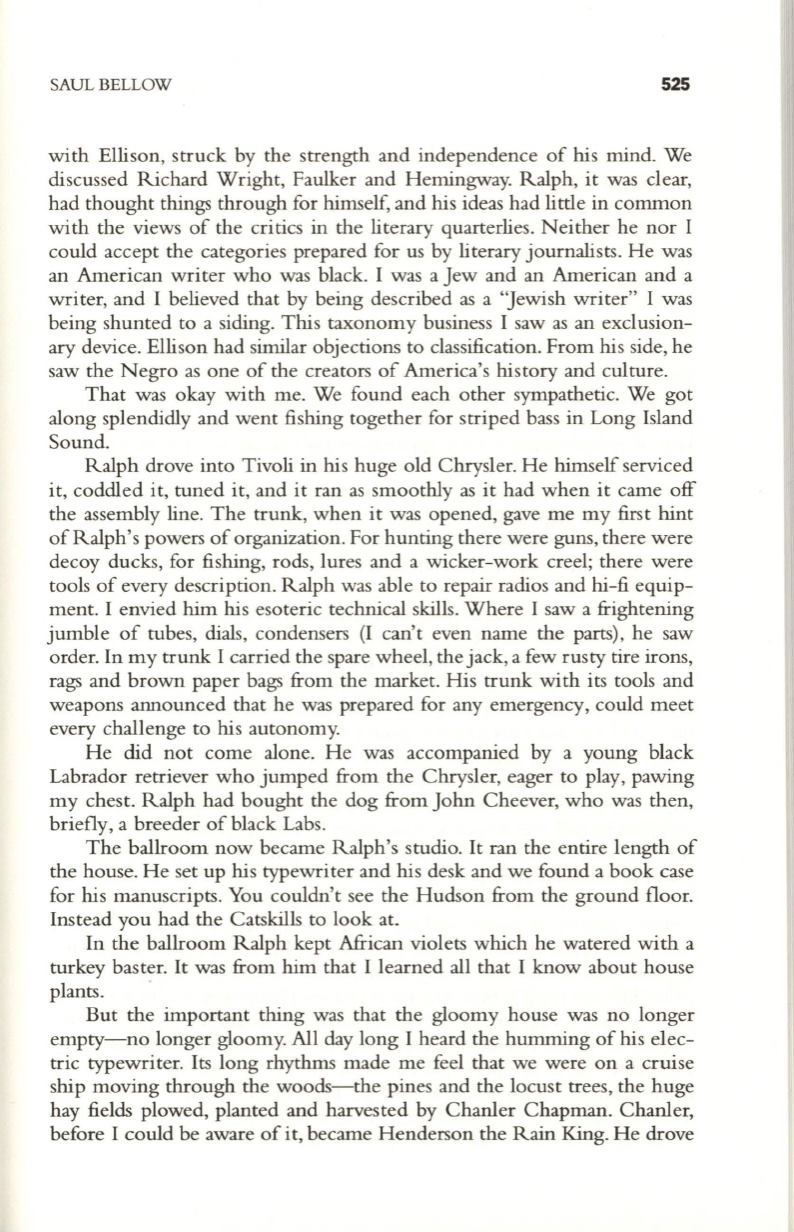
SAUL BELLOW
525
with Ellison, struck by the strength and independence of his mind. We
discussed Richard Wright, Faulker and Hemingway. Ralph, it was clear,
had thought things through for himself, and his ideas had little in common
with the views of the critics in the literary quarterlies. Neither he nor I
could accept the categories prepared for us by literary journalists. He was
an American writer who was black. I was a Jew and an American and a
writer, and I believed that by being described as a "Jewish writer" I was
being shunted to a siding. This taxonomy business I saw as an exclusion–
ary device. Ellison had similar objections to classification. From his side, he
saw the Negro as one of the creators of America's history and culture.
That was okay with me. We found each other sympathetic. We got
along splendidly and went fishing together for striped bass in Long Island
Sound.
Ralph drove into Tivoli in his huge old Chrysler. He himself serviced
it, coddled it, tuned it, and it ran as smoothly as it had when it came off
the assembly line. The trunk, when it was opened, gave me my first hint
of Ralph's powers of organization. For hunting there were guns, there were
decoy ducks, for fishing, rods, lures and a wicker-work creel; there were
tools of every description. Ralph was able to repair radios and hi-fi equip–
ment. I envied him his esoteric technical skills. Where I saw a frightening
jumble of tubes, dials, condensers (I can't even name the parts), he saw
order.
In
my trunk I carried the spare wheel, the jack, a few rusty tire irons,
rags and brown paper bags from the market. His trunk with its tools and
weapons announced that he was prepared for any emergency, could meet
every challenge to his autonomy.
He did not come alone. He was accompanied by a young black
Labrador retriever who jumped from the Chrysler, eager to play, pawing
my chest. Ralph had bought the dog from John Cheever, who was then,
briefly, a breeder of black Labs.
The ballroom now became Ralph's studio. It ran the entire length of
the house. He set up his typewriter and his desk and we found a book case
for his manuscripts. You couldn't see the Hudson from the ground floor.
Instead you had the Catskills to look at.
In
the ballroom Ralph kept African violets which he watered with a
turkey baster.
It
was from
him
that I learned all that I know about house
plants.
But the important thing was that the gloomy house was no longer
empty-no longer gloomy. All day long I heard the humming of his elec–
tric typewri ter. Its long rhythms made me feel that we were on a cruise
ship moving through the woods-the pines and the locust trees, the huge
hay fields plowed, planted and harvested by Chanler Chapman. Chanler,
before I could be aware of it, became Henderson the Rain King. He drove


